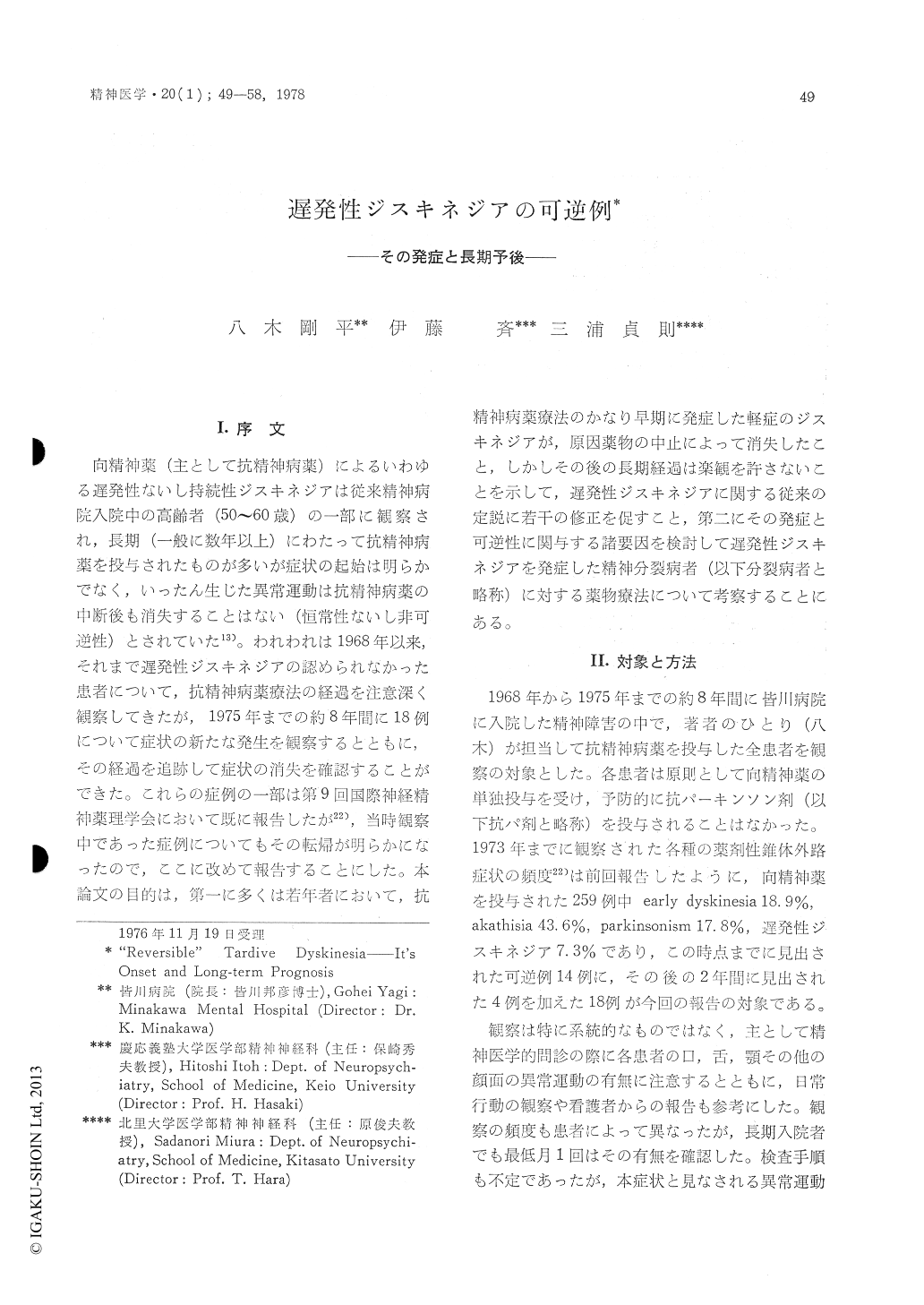1 0 0 0 遅発性ジスキネジアの可逆例—その発症と長期予後
Ⅰ.序文 向精神薬(主として抗精神病薬)によるいわゆる遅発性ないし持続性ジスキネジアは従来精神病院入院中の高齢者(50〜60歳)の一部に観察され,長期(一般に数年以上)にわたって抗精神病薬を投与されたものが多いが症状の起始は明らかでなく,いったん生じた異常運動は抗精神病薬の中断後も消失することはない(恒常性ないし非可逆性)とされていた13)。われわれは1968年以来,それまで遅発性ジスキネジアの認められなかった患者について,抗精神病薬療法の経過を注意深く観察してきたが,1975年までの約8年間に18例について症状の新たな発生を観察するとともに,その経過を追跡して症状の消失を確認することができた。これらの症例の一部は第9回国際神経精神薬理学会において既に報告したが22),当時観察中であった症例についてもその転帰が明らかになったので,ここに改めて報告することにした。本論文の目的は,第一に多くは塔年者において,抗精神病薬療法のかなり早期に発症した軽症のジスキネジアが,原因薬物の中止によって消失したこと,しかしその後の長期経過は楽観を許さないことを示して,遅発性ジスキネジアに関する従来の定説に若干の修正を促すこと,第二にその発症と可逆性に関与する諸要因を検討して遅発性ジスキネジアを発症した精神分裂病者(以下分裂病者と略称)に対する薬物療法について考察することにある。
1 0 0 0 IR 紙芝居形式による「心の理論」高次テスト作成に関する予備的研究 -健常青年の反応特性-
- 著者
- 伊藤 斉子 高原 朗子 土田 玲子 李家 正剛 川村 怜子 津田 剛 瀧上 英一 川崎 千里
- 出版者
- 長崎大学
- 雑誌
- 長崎大学医療技術短期大学部紀要 (ISSN:09160841)
- 巻号頁・発行日
- vol.14, no.1, pp.69-76, 2001-03
高機能自閉症及びアスペルガー障害のコミュニケーション評価を作成するために,日本文化に適合させた「心の理論」高次テストを新たに紙芝居形式にて8話試作した.そしてその妥当性について健常青年76名の回答と作成意図との一致率により検討し予備的研究を行った.その結果,8割以上の一致率を示した話は,嘘を意図した「ガッシャーン」(100%),皮肉「どろんこサトル君」(97.4%),冗談「はい100万円」(93.4%),ふり「ねむたくなーい」(78.9)%で,この4話は妥当性が示唆された.他の4話についても「プレゼント何かな」はふりを伴う罪のない嘘,「荷物がいっぱい」は比喩・ふりを伴う皮肉,「かけっこはやいね」及び「のぞいてみよう」は比喩を伴う冗談の話であることが示唆され,複数の意図を留意すれば妥当性があると考えられた.A test consisted of eight picture-stories, based on the "Advanced Test of Theory of Mind" (Happe, 1994) and its stories culturally-adjusted, was invented to construct some type of occupational-therapeutic index to evaluate communication-abilities of Japanese people with high functioning autism or Asperger's Disorders. Validity of the test was inspected by examining rates of agreement between the answers of 76 subjects (normal young adults) and correct (i.e., researcher-intended) answers on each story. Agreement of the answers on Story 1 ("A Broken Vase" ; Theme A = Lies) , Story 8 ("A Boy Who Got Muddy" ; Theme F = Ironies) , Story 7 (" A Million Yen, Please" ; Theme E = Jokes), and Story 6 (" Not Sleepy Yet!" ; Theme D = Pretense). were 100%, 97.4%, 93.4%, and 78.9%, respectively. For other stories, however, answers of the subjects were scattered over several themes On Story 2 ( " What is the Present?"; Theme B = Innocent lies), most subjects answered identical (64.5%) as intended by the researchers (i.e., innocent lies), but statistically significant numbers of subjects (32.9%) selected Theme D (Pretense) Moreover, on Story 3 ("Too Much Baggage!"; Theme C = Metaphors) most of the answers focused on " metaphors (Theme C) " (50.0%) but some answered " pretense (Theme D) (14.5%) " or " irony (Theme F) (26.3%) ". The answers on two other stories (Story 4 " You Run So Fast! -- Metaphors " & Story 5 " It's a telescope i " -- Pretense " ) unexpectedlly fell more into " jokes (Theme E) " Especially on " metaphor-stories, " many subjects selected " ironies (Theme F) " or " jokes (Theme E) " to reason the story characters' utterance. This seemed to indicate that normal young adults were usually able to understand complexity of relationship among the story characters and to judge their communicative intensions based on it. The present study showed that the Japanese picture-story test presented acceptable level of validity. It was also indicated that the test should be used with care and understanding that some of the stories could contain more than one theme.
